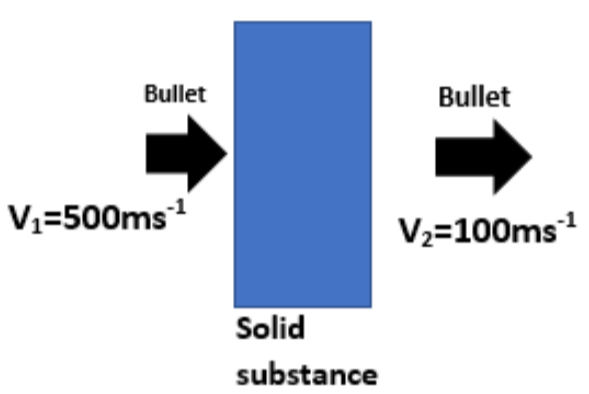
A bullet of mass
Answer
500.4k+ views
Hint: Work-energy theorem states that the variation in kinetic energy of a body is equivalent to the work done by net force acting on it. The kinetic energy of an object is the energy that is possessed due to its motion. It is described as the work required to accelerate a body of a certain mass from rest to the particular velocity. Having gained this energy when it’s accelerating, the body will maintain this kinetic energy until its speed varies.
Complete step by step solution:

From the question, we will get to know that,
Mass of the bullet is given as,
Velocity at which bullet is moving,
Mass of the solid substance through which bullet is passing is
And the velocity of the bullet after passing through the solid substance,
According to the question we can say that the velocity change happened is due to the energy loss in the solid substance, so we can say that,
The velocity change
Substituting the value in it,
Therefore now we can calculate the energy lost in the collision,
Substituting the value in this equation will give,
Hence the correct answer for the question is option D.
Note: There are three different types of collisions, elastic, inelastic, and completely inelastic. In all the cases, momentum is being conserved in all three types of collisions. What compares the collisions is that what happens to the kinetic energy. Inelastic collisions happen when the colliding objects bounce off of each other. This typically happens when we are having colliding objects which are very hard or bouncy. Inelastic collisions happen when the two objects collide and kinetic energy is not being conserved.
Complete step by step solution:

From the question, we will get to know that,
Mass of the bullet is given as,
Velocity at which bullet is moving,
Mass of the solid substance through which bullet is passing is
And the velocity of the bullet after passing through the solid substance,
According to the question we can say that the velocity change happened is due to the energy loss in the solid substance, so we can say that,
The velocity change
Substituting the value in it,
Therefore now we can calculate the energy lost in the collision,
Substituting the value in this equation will give,
Hence the correct answer for the question is option D.
Note: There are three different types of collisions, elastic, inelastic, and completely inelastic. In all the cases, momentum is being conserved in all three types of collisions. What compares the collisions is that what happens to the kinetic energy. Inelastic collisions happen when the colliding objects bounce off of each other. This typically happens when we are having colliding objects which are very hard or bouncy. Inelastic collisions happen when the two objects collide and kinetic energy is not being conserved.
Recently Updated Pages
Master Class 9 General Knowledge: Engaging Questions & Answers for Success

Master Class 9 English: Engaging Questions & Answers for Success

Master Class 9 Science: Engaging Questions & Answers for Success

Master Class 9 Social Science: Engaging Questions & Answers for Success

Master Class 9 Maths: Engaging Questions & Answers for Success

Class 9 Question and Answer - Your Ultimate Solutions Guide

Trending doubts
State and prove Bernoullis theorem class 11 physics CBSE

What are Quantum numbers Explain the quantum number class 11 chemistry CBSE

Who built the Grand Trunk Road AChandragupta Maurya class 11 social science CBSE

1 ton equals to A 100 kg B 1000 kg C 10 kg D 10000 class 11 physics CBSE

State the laws of reflection of light

One Metric ton is equal to kg A 10000 B 1000 C 100 class 11 physics CBSE




